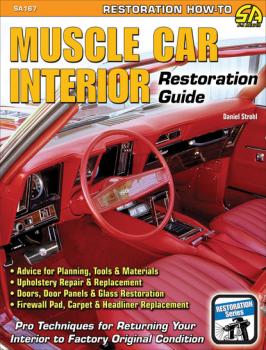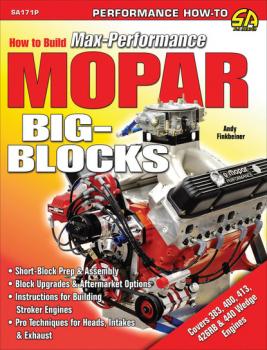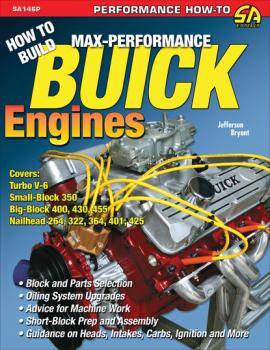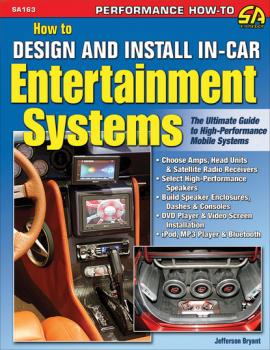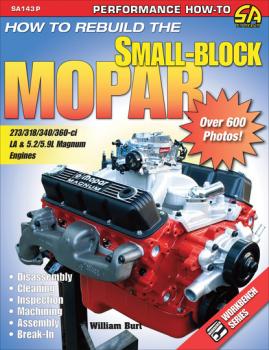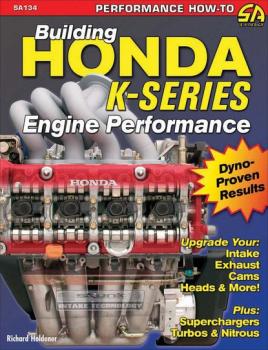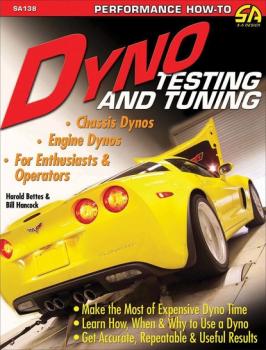MREADZ.COM - много разных книг на любой вкус
Скачивание или чтение онлайн электронных книг.Muscle Car Interior Restoration Guide
The photos in this edition are black and white.<p>A muscle car has not been fully restored until the interior has been returned to original or like-new condition. Whether a car operates in a northern or southern climate, seats, carpets, and other equipment deteriorate and wear out over time. A factory-original and professional-grade interior restoration is critical for enjoying the driving experience. However, many enthusiasts and owners do not fully understand the techniques and procedures necessary to produce a premium-quality or original restoration. <P>While factory service manuals and magazine articles might cover bits and pieces of the interior restoration process, this book has been entirely dedicated to the process of restoring the interior. <I>Muscle Car Interior Restoration</I> provides expert insight into the tools, materials, techniques, and procedures for professionally completing a muscle car restoration. It covers instrument panel and dashboard restoration, electrical system restoration, firewall pad, steering wheel, steering column, and pedal restoration. It also provides insight and expert guidance for restoring carpet, headliners, doors, door panels, glass restoration or replacement, convertible top restoration, upholstery replacement, and vinyl and leather seat repair. <P>With the prices of muscle cars high enough to make Wall Street investors pay attention, a tasteful modified or quality restored interior will mean the difference of thousands – if not tens of thousands of dollars when it comes time to sell. Whether you're looking to cash in with a quality restoration, or just want to make the cockpit of your favorite muscle car a pleasant place to be, this book will help you do the trick.
How to Build Max-Performance Mopar Big Blocks
The photos in this edition are black and white.<p>Starting in the early 1960s, Mopar Wedge engines powered a wide range of Chrysler muscle cars, such as the Dodge Charger, Daytona Charger, Super Bee, Challenger, as well as Plymouth Barracuda, Superbird, Road Runner, GTX, and others. Many times these high-powered muscle cars were pursued by equally high-powered Dodge and Plymouth police cars that were also packing Mopar big-block power under the hood. In 1978, the last of the Mopar big-blocks rolled down the production line, but in an odd twist of fate, the popularity of the Mopar surged again in street and strip cars during the 1980s. By the 1990s, the big Mopar engine was more popular than ever. <p>This book covers how to build Mopar's 383-, 400-, 413-, 426-, and 440-ci engines to power levels of 600 to 900 hp. <i>How to Build Max-Performance Mopar Big Blocks</i> discusses how to properly budget your engine build for a specific performance target and how to select a stock or aftermarket block for the desired performance level. The reciprocating assembly (crankshaft, connecting rods, and pistons) is examined in detail, to help you select the right design and material for durability and performance requirements. Cylinder heads and valvetrain configurations are crucial for generating maximum horsepower and torque. This volume discusses all the stock modification options, the best setups, selecting the right machine work, the latest aftermarket head options for producing huge horsepower, and building stroker engines. The camshafts and lifters chapter compares and contrasts use of hydraulic flat tappet, hydraulic roller, and solid flat tappet cams. In addition, the book explains how to optimize fresh and spent fuel, discussing single- and dual-plane intake manifolds, as well as the exhaust-system design to optimize scavenging. Also details engine builds at 600, 700, 800, and 900 horsepower levels to provide insight and reveal what can be done with real-world component packages.
How to Build Max-Performance Buick Engines
The photos in this edition are black and white.<p>Skylarks, GSXs, Grand Nationals, Rivieras, Gran Sports; the list of formidable performance Buicks is impressive. From the torque monsters of the 1960s to the high-flying Turbo models of the '80s, Buicks have a unique place in performance history. <p>During the 1960s, when word of the mountains of torque supplied by the big-inch Buicks hit the street, nobody wanted to mess with them. Later, big-inch Buicks and the Hemi Chryslers went at it hammer and tongs in stock drag shootouts and in the pages of the popular musclecar magazines of the day. The wars between the Turbo Buicks and Mustang GTs in the 1980s were also legendary, as both cars responded so well to modifications. <p><i>How to Build Max-Performance Buick Engines</i> is the first performance engine book ever published on the Buick family of engines. This book covers everything from the Nailheads of the '50s and early '60s, to the later evolutions of the Buick V-8 through the '60s and '70s, through to the turbo V-6 models of the '70s and '80s. Veteran magazine writer and Buick owner Jefferson Bryant supplies the most up-to-date information on heads, blocks, cams, rotating assemblies, interchangeability, and oiling-system improvements and modifications, along with details on the best performance options available, avenues for aftermarket support, and so much more. Finally, the Buick camp gets the information they have been waiting for, and it's all right here in <i>How to Build Max-Performance Buick Engines</i>.
How to Drift: The Art of Oversteer
The photos in this edition are black and white.<p>Drifting is the newest, most exciting motorsport we have seen in the United States since the invention of the limited slip differential – it may even be the most exhilarating contest man and machine ever devised! <p>From the winding mountain passes and desolate industrial roads of Japan, this unique sport of sliding a car sideways through a series of corners has become a huge hit in America. Drift, or dorifto as they call it Japan, extracts the most exciting portion from various forms of auto racing – the four-wheel drift – and makes it the focus of an extremely intense and visually intoxicating new motor sport. <p><i>How to Drift: The Art of Oversteer</i> is a comprehensive guide to both driving technique and car setup. The author explains various styles and methods of drifting, and provides technical physical descriptions and detailed line art and photos. He goes on to explain how you need to modify your car's suspension, chassis, engine, and driveline to enhance its ability to drift. <p>This book contains more than 350 photos and detailed line drawings.
How to Design and Install In-Car Entertainment Systems
The photos in this edition are black and white.<p>Years ago, enthusiasts had limited in-car entertainment system options. One could install a high-performance head unit, amp, speakers, and upgrade a few other components, and that was about it. Today, in-car entertainment system options are virtually limitless, and they are one of the most popular automotive upgrades. In fact, upgrading or replacing a stock stereo system is just the tip of the in-car entertainment iceberg. <P>Enthusiasts can install a complete entertainment system, including audio and video, MP3 player (iPod), HD radio, satellite radio, and more. Video monitors for DVD and game systems can be incorporated in the dash, head rest, or anywhere else. When you consider GPS navigation and hands-free Bluetooth® cell phone systems, the options are only limited by a person's creativity and budget. <P><I>How to Design and Install In-Car Entertainment Systems</I> presents the entire spectrum of audio/video, navigation, communication, and entertainment technology, and explains how you can create a complete custom system or an integrated stock/aftermarket system. It explains how to plan, select, integrate, and install popular systems under a specific budget for a certain level of performance. This includes design and installation considerations for amps, head units, GPS navigation, iPod integration with head units, satellite radio, digital audio broadcasting, and even computers (carputers). It features how-to installations, thorough explanations for building subwoofer boxes, fabricating kick panels, electrical upgrades such as charging systems, and a comprehensive resource guide.
How to Rebuild the Small-Block Mopar
The photos in this edition are black and white.<p>Small-block Chrysler, Plymouth, and Dodge V-8 engines came in a variety of vehicles since 1964. These powerful, durable engines powered everything from high-performance 'Cudas and Chargers to torquey Dakotas and Ram trucks.<p><i>How to Rebuild the Small-Block Mopar</i> is the most comprehensive book on small-block Mopar engines ever released, covering 273, 318, 340, and 360-ci LA engines and 5.2 and 5.9L Magnum V-8s. Author William Burt uses color photos and descriptive text to teach readers the complete rebuild process from removal to break-in. <p>This book describes ways to increase the performance and efficiency of your small-block Mopar, and also point s out the unique steps required for LA and Magnum versions of the engine. Topics covered include removal, tear down, inspection, selecting parts, machine-shop work, and assembly. Special sidebars cover torque sequences, cc-ing heads, calculating compression ratio, and painting engine parts.
Building Honda K-Series Engine Performance
The photos in this edition are black and white.<p>Honda and Acura practically invented sport-compact performance, and racers have proven that the popular B-series engines can make huge horsepower numbers both boosted and naturally aspirated – but times are changing. The all-new K-series engines are now found in all Honda and Acura performance models, and are also becoming the engine swap of choice. <p><In <i>Building Honda K-Series Engine Performance</i>, author Richard Holdener gives you a detailed description of the K-series engines, the various kinds of aftermarket performance parts available, and describes how these parts perform on the dyno. <p>Each chapter contains numerous color photos and back-to-back dyno tests run on a variety of different test motors including the K20A3, K20A2, K20Z3, K24AZ, and K24A4. You'll find chapters detailing upgrades to the intake, exhaust, cylinder heads, camshafts, and tuning, plus turbochargers, superchargers, and nitrous oxide. Don't spend your hard-earned cash figuring out what works and what doesn't – pick up <i>Building Honda K-Series Engine Performance</i> and know for sure.
How to Build Max-Performance Hemi Engines
The photos in this edition are black and white.<p>Hemi. The word alone evokes images of ultra-high-performance street cars and dominating race cars. No other engine has earned as much street credibility and race success. This engine resides at the pinnacle of American V-8 performance, and cars that carry a Hemi are some of the rarest, most expensive, and legendary muscle cars ever made. When Chrysler threw the wraps off the 426 in 1964, it made history. In the 1964 Daytona 500, the new Hemi-powered stock cars finished 1-2-3-4, announcing Chrysler's new era of dominance in racing. Fast forward to today: recently an immaculate 1970 Plymouth Hemi 'Cuda convertible sold for $2.16 million at a 2006 Barrett Jackson collector car auction. The factory Hemi cars have become legendary, easily eclipsing all other muscle cars in performance and value. <p><i>How to Build Max-Performance Hemi Engines</i> details how to extract even more horsepower out of these incredible engines. All the block options from street versus race, new versus old, and iron versus aluminum are presented. Full detailed coverage on the reciprocating assembly is also included. Heads play an essential role in flowing fuel and producing maximum horsepower, and therefore receive special treatment. Author Richard Nedbal explores major head types, rocker-arm systems, head machining and prep, valves, springs, seats, porting quench control, and much more. All camshaft considerations are discussed as well, so you can select the best specification for your engine build. Induction options including EFI, aftermarket ignitions systems, high-performance oiling systems, and cooling systems are also covered. The book also examines in detail how to install and set up power adders such as nitrous oxide, superchargers, and turbochargers.
HT Restore Your Mustang 1964 1/2-73
The photos in this edition are black and white. <p>In the past, restoration guides have provided authenticity information, such as accurate paint codes, badges, wheels, and other equipment. A bona fide hands-on how-to book for restoring your Mustang from the ground up has not been offered for years. This unique guide will cover the restoration process for every major component group and also provide detailed step-by-step restoration information for the most important procedures. With clear, insightful color photography to accompany this how-to information, any at-home restorer can confidently restore a car and save a substantial amount of money in the process. While restomod books have shown how to install latest technology on vintage muscle cars, this book will focus on factory-accurate restorations, and some simple bolt-on upgrades that do not detract from the collector value but rather enhance the reliability and performance of the car. <I>How to Restore Your Mustang 1964-1/2-1973</I> delivers a detailed explanation for finding the right model, how to assess condition, how to spot a fake, and how to select the right car within your budget. <P>In addition, the book will cover how to plan, prepare, and select the right tools. This unique guide will cover the restoration process for every major component group and also provide detailed step-by-step restoration information for the most important procedures. The latest techniques and best restoration products for each system will be discussed and detailed. Also, the book discusses how to source parts and what you need to consider between new/old stock and reproduction parts. Readers will also learn how to determine if a certain task is best left for a professional shop. All crucial aspects of restoration, including engines, drivelines, body, interior, trim, electrical systems, brakes, steering, and suspension will be profiled.
Dyno Testing & Tuning
Harold and Bill Hancock Bettes
The photos in this edition are black and white.<p><i>Dyno Testing and Tuning</i> is the first book to explain the proper testing procedures that everyone should use to get accurate and useful results from either an engine or chassis dyno. Authors Harold Bettes and Bill Hancock, recognized experts in the performance and racing industry, apply their wealth of knowledge and experience to deliver the definitive work on dynamometers and dyno testing. This book will be useful to anyone who wants to squeeze more power out of their car or engine, but should also be required reading for performance shop owners and dyno operators. <p>The book explains how a dyno works, describes what kinds of data a dyno test can produce, and then shows you how to plan a test session that will give you the results you're looking for. You'll learn what to look for in a dyno facility, how to conduct a dyno test and ensure the accuracy and repeatability of your test, and how to troubleshoot any problems that arise. Sample forms and checklists round out what is sure to be an indispensable book for anyone who wants to make the most of their dyno testing.
